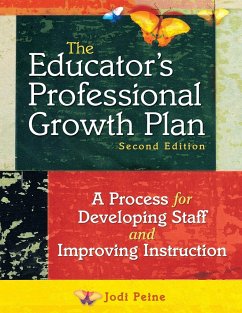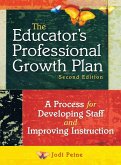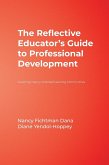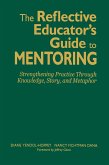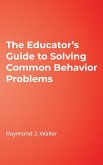Jodi Peine
The Educator's Professional Growth Plan
A Process for Developing Staff and Improving Instruction
Jodi Peine
The Educator's Professional Growth Plan
A Process for Developing Staff and Improving Instruction
- Broschiertes Buch
- Merkliste
- Auf die Merkliste
- Bewerten Bewerten
- Teilen
- Produkt teilen
- Produkterinnerung
- Produkterinnerung
Offers school leaders guidance for designing and implementing a sustainable professional growth process, demonstrates how participants can develop individual action plans, and helps redefine school improvement efforts.
Andere Kunden interessierten sich auch für
![The Educator's Professional Growth Plan The Educator's Professional Growth Plan]() Jodi PeineThe Educator's Professional Growth Plan98,99 €
Jodi PeineThe Educator's Professional Growth Plan98,99 €![The Reflective Educator's Guide to Professional Development The Reflective Educator's Guide to Professional Development]() Nancy Fichtman DanaThe Reflective Educator's Guide to Professional Development89,99 €
Nancy Fichtman DanaThe Reflective Educator's Guide to Professional Development89,99 €![The Reflective Educator's Guide to Mentoring The Reflective Educator's Guide to Mentoring]() Diane Yendol-HoppeyThe Reflective Educator's Guide to Mentoring78,99 €
Diane Yendol-HoppeyThe Reflective Educator's Guide to Mentoring78,99 €![Publish or Perish - The Educator's Imperative Publish or Perish - The Educator's Imperative]() Allan A. GlatthornPublish or Perish - The Educator's Imperative87,99 €
Allan A. GlatthornPublish or Perish - The Educator's Imperative87,99 €![The Educator's Guide to Solving Common Behavior Problems The Educator's Guide to Solving Common Behavior Problems]() Raymond J. WallerThe Educator's Guide to Solving Common Behavior Problems67,99 €
Raymond J. WallerThe Educator's Guide to Solving Common Behavior Problems67,99 €![The Special Educator's Reflective Calendar and Planning Journal The Special Educator's Reflective Calendar and Planning Journal]() Mary Zabolio McGrathThe Special Educator's Reflective Calendar and Planning Journal31,99 €
Mary Zabolio McGrathThe Special Educator's Reflective Calendar and Planning Journal31,99 €![The Educator's Guide to Emotional Intelligence and Academic Achievement The Educator's Guide to Emotional Intelligence and Academic Achievement]() Maurice J. EliasThe Educator's Guide to Emotional Intelligence and Academic Achievement99,99 €
Maurice J. EliasThe Educator's Guide to Emotional Intelligence and Academic Achievement99,99 €-
-
-
Offers school leaders guidance for designing and implementing a sustainable professional growth process, demonstrates how participants can develop individual action plans, and helps redefine school improvement efforts.
Hinweis: Dieser Artikel kann nur an eine deutsche Lieferadresse ausgeliefert werden.
Hinweis: Dieser Artikel kann nur an eine deutsche Lieferadresse ausgeliefert werden.
Produktdetails
- Produktdetails
- Verlag: Corwin
- 2. Auflage
- Seitenzahl: 258
- Erscheinungstermin: 26. Juli 2007
- Englisch
- Abmessung: 280mm x 216mm x 14mm
- Gewicht: 658g
- ISBN-13: 9781412949323
- ISBN-10: 1412949327
- Artikelnr.: 22594713
- Herstellerkennzeichnung
- Books on Demand GmbH
- In de Tarpen 42
- 22848 Norderstedt
- info@bod.de
- 040 53433511
- Verlag: Corwin
- 2. Auflage
- Seitenzahl: 258
- Erscheinungstermin: 26. Juli 2007
- Englisch
- Abmessung: 280mm x 216mm x 14mm
- Gewicht: 658g
- ISBN-13: 9781412949323
- ISBN-10: 1412949327
- Artikelnr.: 22594713
- Herstellerkennzeichnung
- Books on Demand GmbH
- In de Tarpen 42
- 22848 Norderstedt
- info@bod.de
- 040 53433511
Jodi Peine is recently retired after 33 years in education. The last 13 years of her career were spent as a principal and Director of Curriculum and Instruction at Community Unit School District 702 in Tremont, Illinois. Jodi is also an adjunct college instructor and has presented at national and regional educational conferences on such topics as staff development, the professional growth plan, school leadership, supervision and curriculum, and the arts in education. She currently serves as an independent consultant to school districts.
Preface
Acknowledgments
Introduction
1. Professional Growth: Defining the What, Why, Who, and How
What Is Professional Growth?
What Is a Professional Growth Plan?
What Is the Professional Growth Plan Process?
Why Use the Professional Growth Plan Process?
Who Can Use a Growth Plan?
Who Can Lead the Professional Growth Plan Process?
How to Implement the Professional Growth Plan Process Successfully
Encouraging New Traditions in Professional Growth
2. Managing the Professional Growth Plan Process
Operational Issues
Allocating Resources
Available Resources vs. Needs? - A Balancing Act
Who Has the Time?
Organizing People, Events, and Information
Forms? - How Can They Help?
Introducing the Process to Staff
The School Leader as Coach and Advisor
3. Identifying Areas for Professional Growth
The First of Four Phases
Targeting Professional Growth
Conducting a Personal Needs Assessment
Comparing Current Practices to Established Professional Performance
Standards/Best Practice Research
Review and Understand Professional Performance Standards and Best Practices
Research
The Self-Assessment Activity
Examining Relevant Student Performance Data
Facilitating Data Analysis
Linking Practice and Performance
Addressing Deficiencies and Discrepancies
Needs - Assessment and the School Leader
The Needs - Assessment Conference
The Needs Assessment Conference Record
4. Designing the Professional Growth Plan
The Second Phase: Plan Design
Guiding the Design Process
Establishing Professional Goals
Establishing Learner-Centered Goals
Can Goals Change?
Establishing the Questions
Creating the Essential Question
Creating Related Questions
Designing an Action Plan
Identifying Modes of Documentation
Documentation: A Product and a Process
Identifying Baseline Data
Defining Methods of Evaluation
Identifying Resource Needs
Choosing a Method for Sharing Results With the Learning Community
Finalizing the Growth Plan
5. Professional Growth Plans in Progress
Implementation and Monitoring
Monitoring the Process
Formal Monitoring: Progress Meetings
Informal Monitoring: Listening, Watching, Visiting
Deciding What Is Not Working and Why
Interim Sharing: What Has Happened so Far?
Troubleshooting? What Happens If. . . .
Preparing for the Final Phase
6. Completing the Growth Plan Process
Plan Evaluation
Growth Plan Summary Activities
Summarizing the Growth Plan Experience? What Happened?
The Growth Plan Summary Conference
Evaluating Documentation of Professional Growth
Sharing With the Learning Community
Wrapping Up the Professional Growth Plan Process
7. The Process Continues
Second Generation Plans and Beyond
Impediments to the Process
Changes in Personnel
Inconsistent Implementation
Lack of Administrative Support
The Demands of Compliance Directives and Documentation
The Professional Growth Plan Process Is School Improvement
The School Leader as Mechanic and Change Agent
Appendix A: School Leader Blacklines
Appendix B: Participant Blacklines
References
Index
Acknowledgments
Introduction
1. Professional Growth: Defining the What, Why, Who, and How
What Is Professional Growth?
What Is a Professional Growth Plan?
What Is the Professional Growth Plan Process?
Why Use the Professional Growth Plan Process?
Who Can Use a Growth Plan?
Who Can Lead the Professional Growth Plan Process?
How to Implement the Professional Growth Plan Process Successfully
Encouraging New Traditions in Professional Growth
2. Managing the Professional Growth Plan Process
Operational Issues
Allocating Resources
Available Resources vs. Needs? - A Balancing Act
Who Has the Time?
Organizing People, Events, and Information
Forms? - How Can They Help?
Introducing the Process to Staff
The School Leader as Coach and Advisor
3. Identifying Areas for Professional Growth
The First of Four Phases
Targeting Professional Growth
Conducting a Personal Needs Assessment
Comparing Current Practices to Established Professional Performance
Standards/Best Practice Research
Review and Understand Professional Performance Standards and Best Practices
Research
The Self-Assessment Activity
Examining Relevant Student Performance Data
Facilitating Data Analysis
Linking Practice and Performance
Addressing Deficiencies and Discrepancies
Needs - Assessment and the School Leader
The Needs - Assessment Conference
The Needs Assessment Conference Record
4. Designing the Professional Growth Plan
The Second Phase: Plan Design
Guiding the Design Process
Establishing Professional Goals
Establishing Learner-Centered Goals
Can Goals Change?
Establishing the Questions
Creating the Essential Question
Creating Related Questions
Designing an Action Plan
Identifying Modes of Documentation
Documentation: A Product and a Process
Identifying Baseline Data
Defining Methods of Evaluation
Identifying Resource Needs
Choosing a Method for Sharing Results With the Learning Community
Finalizing the Growth Plan
5. Professional Growth Plans in Progress
Implementation and Monitoring
Monitoring the Process
Formal Monitoring: Progress Meetings
Informal Monitoring: Listening, Watching, Visiting
Deciding What Is Not Working and Why
Interim Sharing: What Has Happened so Far?
Troubleshooting? What Happens If. . . .
Preparing for the Final Phase
6. Completing the Growth Plan Process
Plan Evaluation
Growth Plan Summary Activities
Summarizing the Growth Plan Experience? What Happened?
The Growth Plan Summary Conference
Evaluating Documentation of Professional Growth
Sharing With the Learning Community
Wrapping Up the Professional Growth Plan Process
7. The Process Continues
Second Generation Plans and Beyond
Impediments to the Process
Changes in Personnel
Inconsistent Implementation
Lack of Administrative Support
The Demands of Compliance Directives and Documentation
The Professional Growth Plan Process Is School Improvement
The School Leader as Mechanic and Change Agent
Appendix A: School Leader Blacklines
Appendix B: Participant Blacklines
References
Index
Preface
Acknowledgments
Introduction
1. Professional Growth: Defining the What, Why, Who, and How
What Is Professional Growth?
What Is a Professional Growth Plan?
What Is the Professional Growth Plan Process?
Why Use the Professional Growth Plan Process?
Who Can Use a Growth Plan?
Who Can Lead the Professional Growth Plan Process?
How to Implement the Professional Growth Plan Process Successfully
Encouraging New Traditions in Professional Growth
2. Managing the Professional Growth Plan Process
Operational Issues
Allocating Resources
Available Resources vs. Needs? - A Balancing Act
Who Has the Time?
Organizing People, Events, and Information
Forms? - How Can They Help?
Introducing the Process to Staff
The School Leader as Coach and Advisor
3. Identifying Areas for Professional Growth
The First of Four Phases
Targeting Professional Growth
Conducting a Personal Needs Assessment
Comparing Current Practices to Established Professional Performance
Standards/Best Practice Research
Review and Understand Professional Performance Standards and Best Practices
Research
The Self-Assessment Activity
Examining Relevant Student Performance Data
Facilitating Data Analysis
Linking Practice and Performance
Addressing Deficiencies and Discrepancies
Needs - Assessment and the School Leader
The Needs - Assessment Conference
The Needs Assessment Conference Record
4. Designing the Professional Growth Plan
The Second Phase: Plan Design
Guiding the Design Process
Establishing Professional Goals
Establishing Learner-Centered Goals
Can Goals Change?
Establishing the Questions
Creating the Essential Question
Creating Related Questions
Designing an Action Plan
Identifying Modes of Documentation
Documentation: A Product and a Process
Identifying Baseline Data
Defining Methods of Evaluation
Identifying Resource Needs
Choosing a Method for Sharing Results With the Learning Community
Finalizing the Growth Plan
5. Professional Growth Plans in Progress
Implementation and Monitoring
Monitoring the Process
Formal Monitoring: Progress Meetings
Informal Monitoring: Listening, Watching, Visiting
Deciding What Is Not Working and Why
Interim Sharing: What Has Happened so Far?
Troubleshooting? What Happens If. . . .
Preparing for the Final Phase
6. Completing the Growth Plan Process
Plan Evaluation
Growth Plan Summary Activities
Summarizing the Growth Plan Experience? What Happened?
The Growth Plan Summary Conference
Evaluating Documentation of Professional Growth
Sharing With the Learning Community
Wrapping Up the Professional Growth Plan Process
7. The Process Continues
Second Generation Plans and Beyond
Impediments to the Process
Changes in Personnel
Inconsistent Implementation
Lack of Administrative Support
The Demands of Compliance Directives and Documentation
The Professional Growth Plan Process Is School Improvement
The School Leader as Mechanic and Change Agent
Appendix A: School Leader Blacklines
Appendix B: Participant Blacklines
References
Index
Acknowledgments
Introduction
1. Professional Growth: Defining the What, Why, Who, and How
What Is Professional Growth?
What Is a Professional Growth Plan?
What Is the Professional Growth Plan Process?
Why Use the Professional Growth Plan Process?
Who Can Use a Growth Plan?
Who Can Lead the Professional Growth Plan Process?
How to Implement the Professional Growth Plan Process Successfully
Encouraging New Traditions in Professional Growth
2. Managing the Professional Growth Plan Process
Operational Issues
Allocating Resources
Available Resources vs. Needs? - A Balancing Act
Who Has the Time?
Organizing People, Events, and Information
Forms? - How Can They Help?
Introducing the Process to Staff
The School Leader as Coach and Advisor
3. Identifying Areas for Professional Growth
The First of Four Phases
Targeting Professional Growth
Conducting a Personal Needs Assessment
Comparing Current Practices to Established Professional Performance
Standards/Best Practice Research
Review and Understand Professional Performance Standards and Best Practices
Research
The Self-Assessment Activity
Examining Relevant Student Performance Data
Facilitating Data Analysis
Linking Practice and Performance
Addressing Deficiencies and Discrepancies
Needs - Assessment and the School Leader
The Needs - Assessment Conference
The Needs Assessment Conference Record
4. Designing the Professional Growth Plan
The Second Phase: Plan Design
Guiding the Design Process
Establishing Professional Goals
Establishing Learner-Centered Goals
Can Goals Change?
Establishing the Questions
Creating the Essential Question
Creating Related Questions
Designing an Action Plan
Identifying Modes of Documentation
Documentation: A Product and a Process
Identifying Baseline Data
Defining Methods of Evaluation
Identifying Resource Needs
Choosing a Method for Sharing Results With the Learning Community
Finalizing the Growth Plan
5. Professional Growth Plans in Progress
Implementation and Monitoring
Monitoring the Process
Formal Monitoring: Progress Meetings
Informal Monitoring: Listening, Watching, Visiting
Deciding What Is Not Working and Why
Interim Sharing: What Has Happened so Far?
Troubleshooting? What Happens If. . . .
Preparing for the Final Phase
6. Completing the Growth Plan Process
Plan Evaluation
Growth Plan Summary Activities
Summarizing the Growth Plan Experience? What Happened?
The Growth Plan Summary Conference
Evaluating Documentation of Professional Growth
Sharing With the Learning Community
Wrapping Up the Professional Growth Plan Process
7. The Process Continues
Second Generation Plans and Beyond
Impediments to the Process
Changes in Personnel
Inconsistent Implementation
Lack of Administrative Support
The Demands of Compliance Directives and Documentation
The Professional Growth Plan Process Is School Improvement
The School Leader as Mechanic and Change Agent
Appendix A: School Leader Blacklines
Appendix B: Participant Blacklines
References
Index

